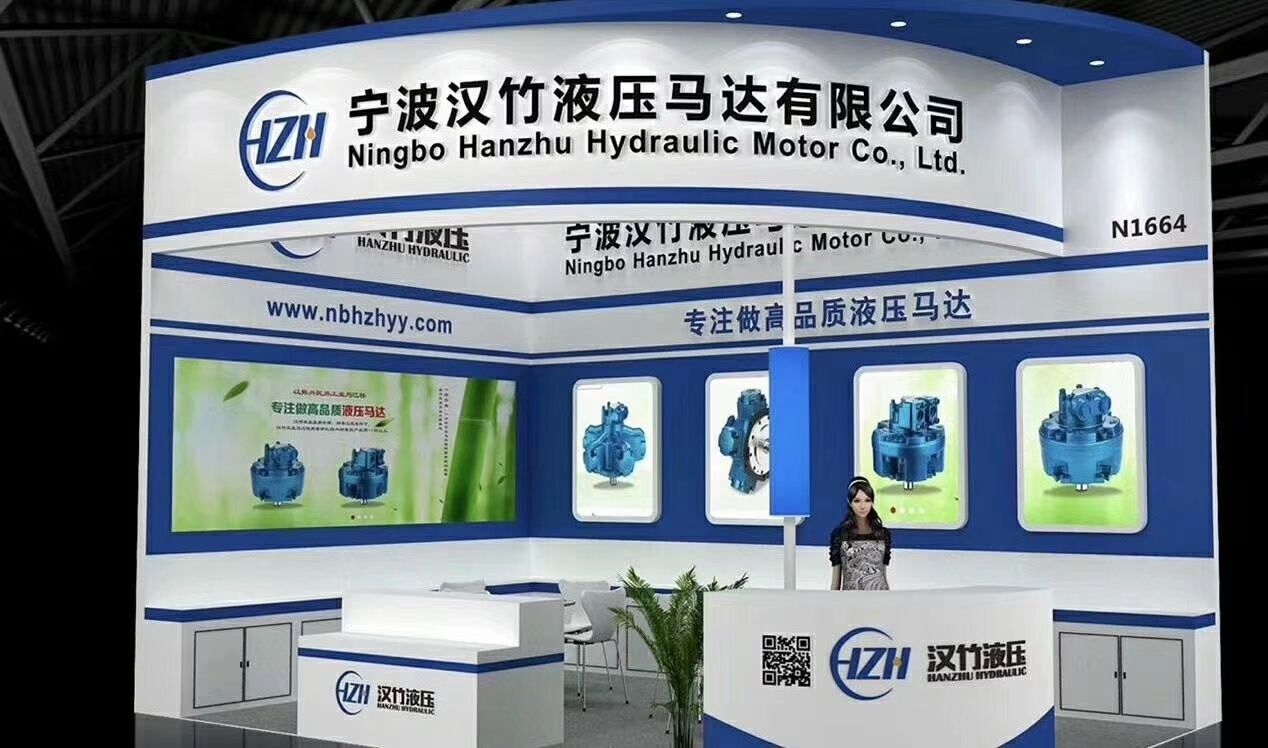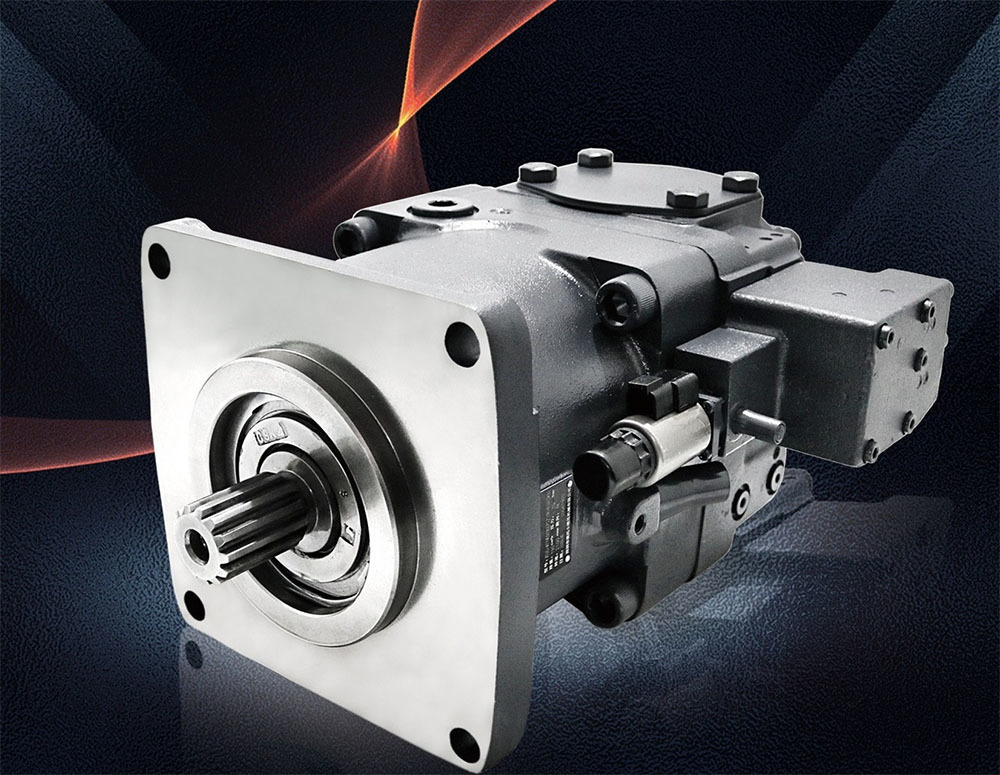Han Bamboo Hydraulics tells you about the use and maintenance of engineering machinery hydraulic plunger pumps
The efficiency of a hydraulic system in engineering machinery primarily depends on the volumetric efficiency of the hydraulic pump. When the volumetric efficiency drops to 72%, routine maintenance is required, including replacing bearings and aged seals, and repairing or replacing friction pairs exceeding the allowable clearance to restore performance.
1 Hydraulic Pump Oil Supply Methods
Axial-swashplate piston pumps are divided into two types: pressure oil supply type and self-priming type. Pressure oil supply type hydraulic pumps mostly use a pressurized oil tank, and some hydraulic pumps themselves have a booster pump to supply pressure oil to the hydraulic pump inlet. Self-priming hydraulic pumps have strong self-priming ability and do not require external oil supply.
For hydraulic oil tanks supplied by air pressure, after each machine startup, it is necessary to wait until the hydraulic tank reaches the operating air pressure before operating the machinery. If the air pressure in the hydraulic oil tank is insufficient when the machine is running, it will cause the hydraulic pump and the swashplate to be pulled off, resulting in abnormal wear of the return plate and pressure plate in the pump body. For piston pumps using a booster pump for oil supply, after 3000 hours of use, operators need to check the piston pump 1-2 times a day to check whether the hydraulic pump is running normally. If a decrease in hydraulic cylinder speed or stalling is found, the booster pump should be disassembled and inspected to check for scratches on the impeller edge and whether the internal gear pump clearance is too large.
For self-priming piston pumps, the oil level in the hydraulic oil tank must not be lower than the lower limit of the oil level indicator, and a sufficient amount of hydraulic oil must be maintained. The higher the cleanliness of the hydraulic oil, the longer the service life of the hydraulic pump.
2 Hydraulic Pump Bearings
The most important part of a piston pump is the bearing. If the bearing has clearance, the normal clearance of the three pairs of friction pairs inside the hydraulic pump cannot be guaranteed, and the thickness of the hydrostatic supporting oil film of each friction pair will also be damaged, reducing the service life of the piston pump bearing. According to the data provided by the hydraulic pump manufacturer, the average service life of the bearing is 10000 hours, and it needs to be replaced after exceeding this value.
For disassembled bearings, it is impossible to detect the bearing clearance without professional testing instruments. Only visual inspection can be used. If scratches or discoloration are found on the roller surface, it must be replaced.
When replacing bearings, pay attention to the English letters and model numbers of the original bearings. Piston pump bearings mostly use high load capacity bearings. It is best to purchase products from the original manufacturer and original specifications. If another brand is replaced, consult experienced bearing personnel to check the table for replacement. The purpose is to maintain the bearing's precision grade and load capacity.
3 Inspection and Repair of Three Pairs of Friction Pairs
3.1 Piston Rod and Cylinder Bore
Table 1 shows the replacement standards for piston pump parts (see Figure 1). When the various clearances listed in the table exceed the tolerance, the following methods can be used for repair:
(1) For cylinder bodies with inlaid bronze bushings, the bronze bushings can be replaced for repair. First, adjust the diameter of a set of piston rods to a uniform size, and then polish the outer diameter with sandpaper of 1000# or higher.
Three methods for installing bronze bushings in the cylinder body:
(a) Heat the cylinder body for hot installation or freeze the bronze bushing for cold pressing, interference fit; (b) Use Loctite adhesive for assembly. This method requires grooves on the outer surface of the bronze bushing; (c) Tap the cylinder bore, machine the outer diameter of the bronze bushing into threads, apply Loctite adhesive, and then screw in for assembly.
(2) Repair methods for cylinder bodies and bronze bushings with brazing bonding are as follows:
(a) Use a grinding rod to manually or mechanically grind and repair the cylinder bore; (b) Use a coordinate boring machine to re-bore the cylinder bore; (c) Use a reamer to repair the cylinder bore.
(3) Use "surface engineering technology", the methods are as follows:
(a) Electroplating technology: Plate a layer of hard chromium on the piston surface; (b) Electroblasting technology: Brush-plate wear-resistant materials on the piston surface; (c) Thermal spraying, arc spraying, or electrospraying: Spray high-carbon martensite wear-resistant materials; (d) Laser cladding: Cladding high-hardness wear-resistant alloy powder on the piston surface.
(4) The cylinder body material without bronze bushings is mostly ductile iron, and an amorphous thin film or coating is prepared on the inner wall of the cylinder body. Because the inner wall of the cylinder bore has this special substance, a hard-hard pair of friction pairs can be formed. If the cylinder bore is blindly ground, the surface material on the inner wall of the cylinder bore will be ground off, and the friction structure and performance will change. If the friction pair with the coating removed is forcibly used, the friction surface temperature will rise sharply, and the piston rod and cylinder bore will bond together.
In addition, a unique thin film coating is prepared on the surface of the piston rod, which has the functions of reducing friction, wear resistance, and lubrication. This friction pair is actually still a hard-soft pair. Once the coating is changed, the best matching material of the friction pair will be destroyed. Repairing these special piston pumps requires sending them to a professional repair shop.
3.2 Swashplate and Shoe
The sliding friction between the swashplate and the shoe is the most complex pair of the three friction pairs in the swashplate piston pump.
Table 1 lists the clearance between the piston rod ball head and the shoe ball socket (see Figure 2). If the clearance between the piston and the shoe exceeds the tolerance, the high-pressure oil in the piston chamber will leak from the gap between the piston ball head and the shoe, the oil film between the shoe and the swashplate will thin, and in severe cases, hydrostatic support will fail, causing metal-to-metal friction between the shoe and the swashplate, resulting in shoe erosion and shedding, and scratching of the piston ball head on the swashplate. When the clearance between the piston rod ball head and the shoe ball socket exceeds 1.5 times the tolerance, they must be replaced as a group.
Piston Rod and Cylinder Bore Piston Rod Diameter φ16 φ20 φ25 φ30 φ35 φ40
Standard Clearance 0.015 0.025 0.025 0.030 0.035 0.040
Limit Clearance 0.040 0.050 0.060 0.070 0.080 0.090
Piston Rod Ball Head
And Swashplate Ball Socket Standard Clearance 0.010 0.010 0.015 0.015 0.020 0.020
Limit Clearance 0.30 0.30 0.30 0.35 0.35 0.35
After a period of operation, the swash plate surface will exhibit an inward concave phenomenon. Before platform grinding is employed, the original dimensions and surface hardness should be measured first. After grinding, the amount of grinding should be measured. If it is within 0.18 mm, it will not hinder the use of the plunger pump; if it exceeds 0.2 mm, nitriding should be used to maintain the original nitriding layer thickness.
When the swash plate surface is scraped by the plunger ball head, the laser cladding alloy powder method can be used for repair. Laser cladding technology can ensure both the bonding strength of the material and the hardness of the cladding material, without significantly reducing the hardness of the surrounding tissue.
Chromium-based welding rods can also be used for manual overlay welding. The repaired swash plate surface needs to be re-heat treated, preferably using a nitriding furnace. Regardless of the method used to repair the swash plate, the original dimensional accuracy, hardness, and surface roughness must be restored.
3.3 Repair of the distributor plate and cylinder body distribution surface
Distributor plates come in two forms: planar distribution and spherical distribution.
For spherical distribution friction pairs, when the scratches on the cylinder body distribution surface are relatively shallow, they can be repaired by grinding; when the grooves on the cylinder body distribution surface are deeper, "surface engineering technology" should be used to fill the grooves first, and then grinding should be performed. Blind grinding should be avoided to prevent the copper layer from becoming thin or oil leaking from the steel base.
Planar distribution friction pairs can be ground on a platform with relatively high precision.
Before grinding the cylinder body and distributor plate, the total thickness and the amount to be ground should be measured first, and then compensated on the adjustment pad. When the distributor plate grinding amount is large, it should be re-heat treated after grinding to ensure the hardness of the hardened layer (see Table 2).
Table 2 Hardness Standards for Plunger Pump Parts
Recommended hardness for plunger rod: HS84
Recommended hardness for plunger rod ball head: >HS90
Recommended surface hardness for swash plate: >HS90
Recommended hardness for distributor plate: >HS90
After repairing the cylinder body and distributor plate, the following method can be used to check the leakage of the mating surface: apply Vaseline oil to the distributor plate surface, block the oil leakage channel, place the oiled distributor plate flat on a platform or flat glass, then place the cylinder body on the distributor plate, and inject diesel oil into the cylinder holes. Inject oil intermittently, that is, inject oil into one hole and not into another, and observe for more than 4 hours. If there is no leakage or communication of diesel oil in the plunger holes, it indicates that the grinding of the cylinder body and distributor plate is qualified.
4 Conclusion
The service life of a plunger pump is related to regular maintenance, the quantity and quality of hydraulic oil, and oil cleanliness. Avoiding wear of the plunger pump friction pair by particles in the oil is also an effective way to extend the service life of the plunger pump.
During maintenance, replacement parts should use original factory parts as much as possible. These parts may be more expensive than other imitation parts, but their quality and stability are better. If you purchase inexpensive imitation parts, it may seem to save money in the short term, but it will bring hidden dangers and may cause greater harm to the use of the plunger pump.
More news
03/14
2025
03/14
2025









